Global hearing aids market is estimated to be valued at USD 8.64 Bn in 2025 and is expected to reach USD 13.52 Bn by 2032, exhibiting a compound annual growth rate (CAGR) of 6.6% from 2025 to 2032.
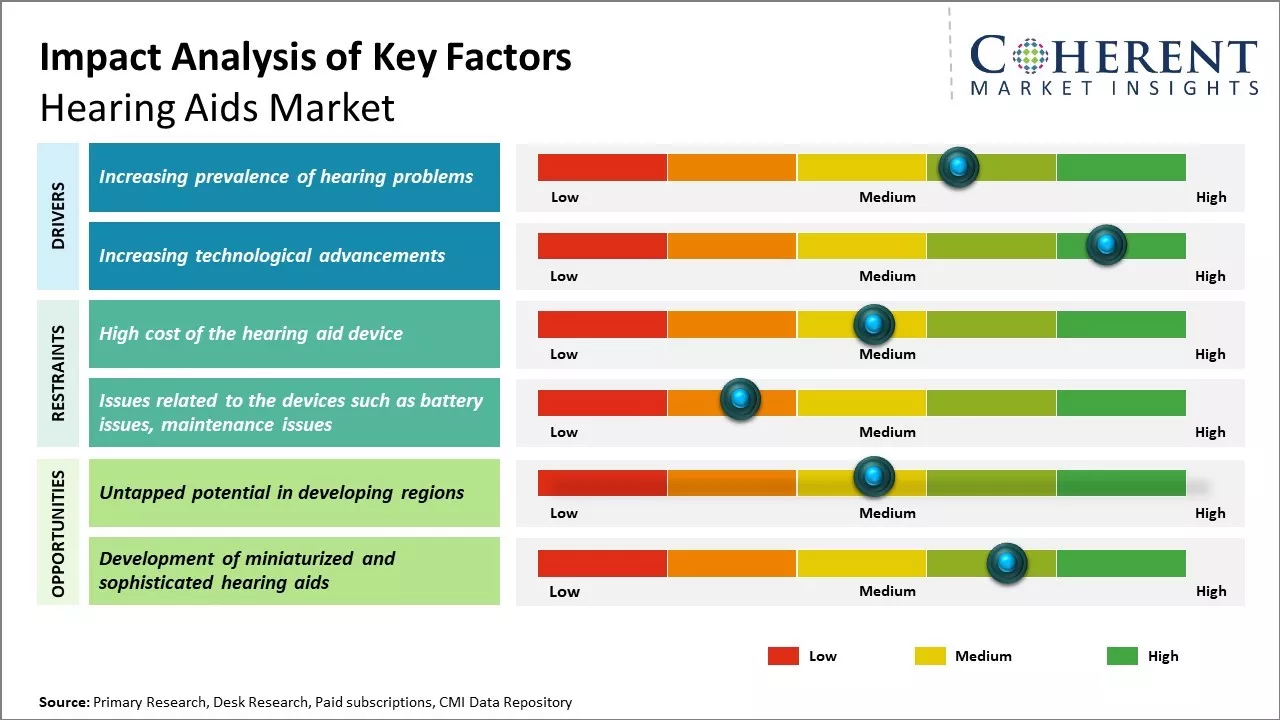
Discover market dynamics shaping the industry: Request sample copy
Global hearing aids market is expected to witness positive growth over the forecast period. There is an increasing prevalence of hearing loss majorly among the geriatric population globally. Growing noise pollution levels and increased adoption of unsafe listening habits among consumers is also contributing to the rising cases of hearing impairment. Further, innovation led by key players in terms of the development of miniature and sophisticated hearing aid technologies is supporting the market expansion. However, issues related to the social stigma associated with hearing loss and high cost of hearing aids are likely to hinder the market growth to some extent during the forecast period.
Increasing prevalence of hearing problems
Increasing prevalence of hearing problems such as ear infections, hearing loss, and others is expected to boost the global hearing aids market growth during the forecast period. For instance, in April 2021, according to the World Health Organization (WHO), due to unsafe listening practices, around 1 billion young adults were at risk of permanent and avoidable hearing loss. In addition, based on the same source, almost 80% of the patients with severe hearing loss lived in low and middle-income countries. The hearing loss incidences are increasing with age of the person. Approximately 25% of people over the age of 60 have disabling hearing loss.
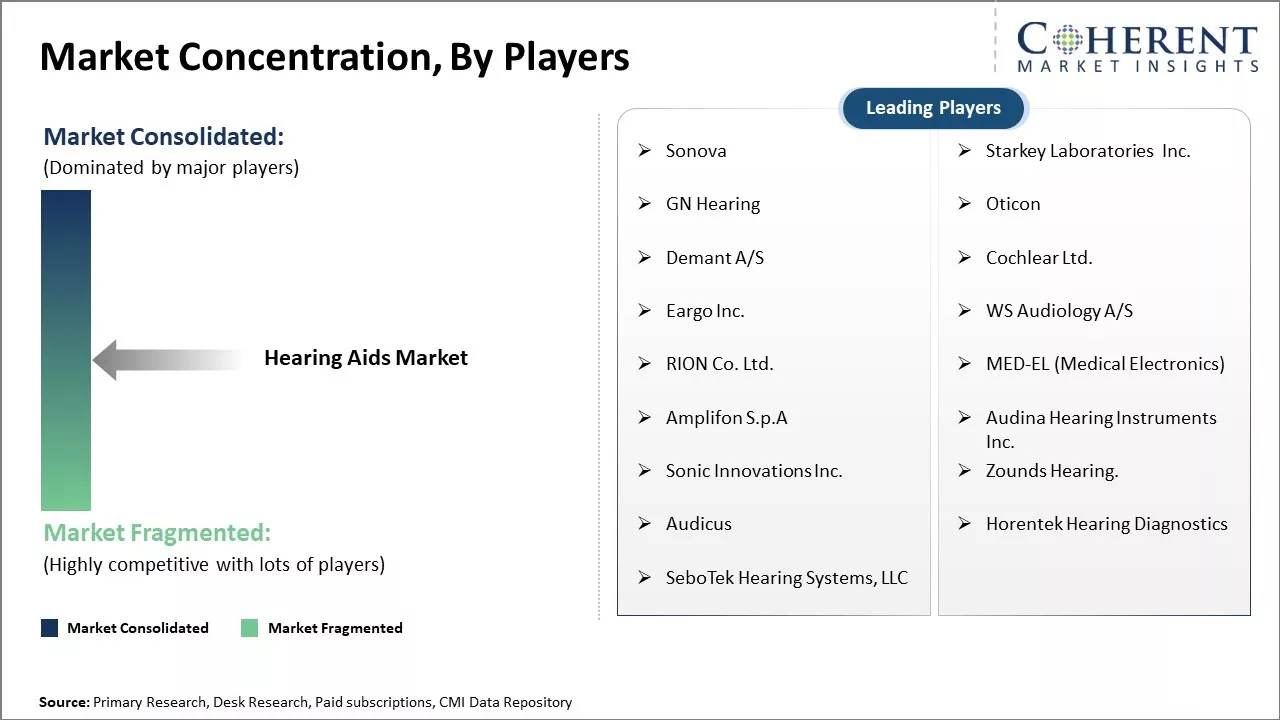
Get actionable strategies to beat competition: Request sample copy
Increasing technological advancementsIncreasing technological advancements in the hearing aid devices is one of the major factors that are responsible for fueling the market growth of global hearing aids market. For instance, in June 2021, Widex USA Inc., a company that offers hearing solutions, launched a technology, My Sound, an artificial intelligence (AI)-based solution that enables user-driven sound personalization. AI technology leverages Widex users' cloud-based user data to provide informed profile recommendations based on the person's current activity.
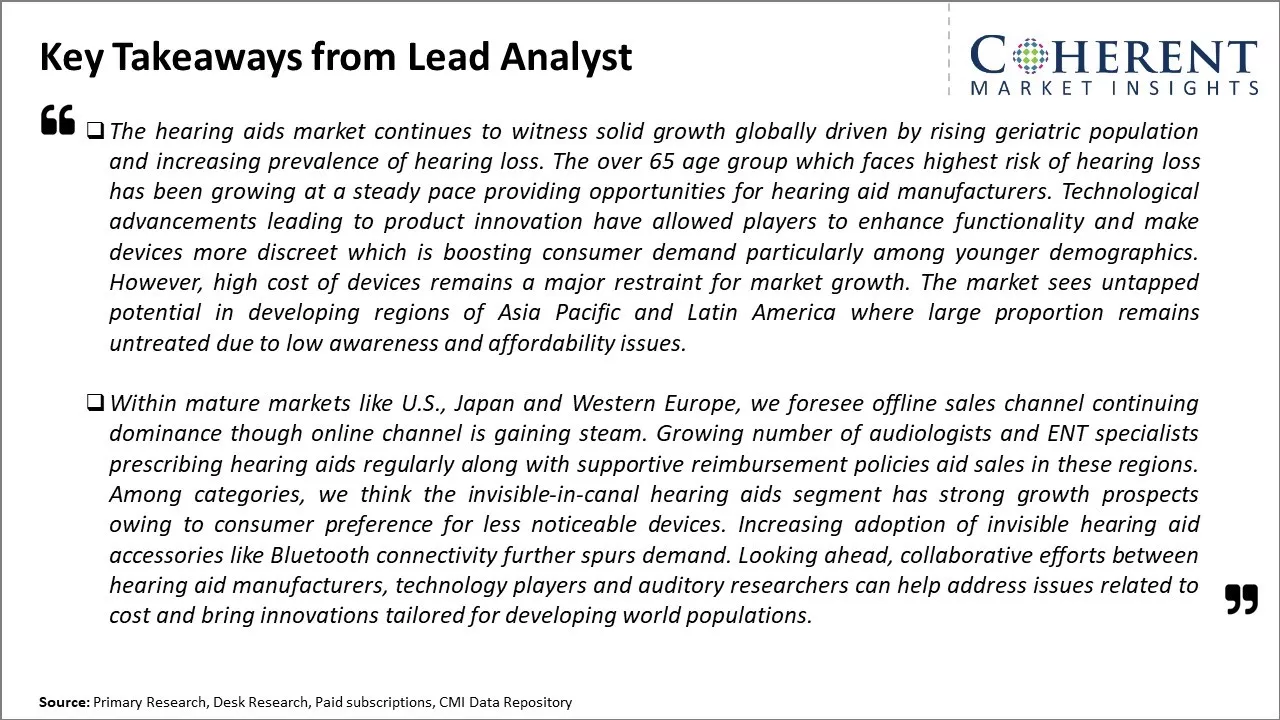
To learn more about this report, Request sample copy
Market Challenges: High cost of the hearing aid devicesThe major factors that restrict growth of the global hearing aids market include high cost of the hearing aid devices associated with issues related to the devices such as battery issues, maintenance issues. For instance, in June 2021, according to Healthy Hearing, the directory of hearing clinics in the U.S., hearing aid prices can range from around USD 1,000 to more than USD 6,000 per device, depending on the technology used in the hearing aid.
Market Opportunities: Untapped potential in developing regions
The potential for growth in the global hearing aids market is substantial, particularly in developing regions across the world. Regions such as Southeast Asia, Latin America, and parts of Africa presently exhibit hearing aid penetration rates significantly lower than those observed in developed nations. This untapped pool of potential users represents a major opportunity for hearing aid manufacturers. As economies in developing areas continue to grow and populations become more health-conscious, demand for hearing aids is likely to rise substantially.
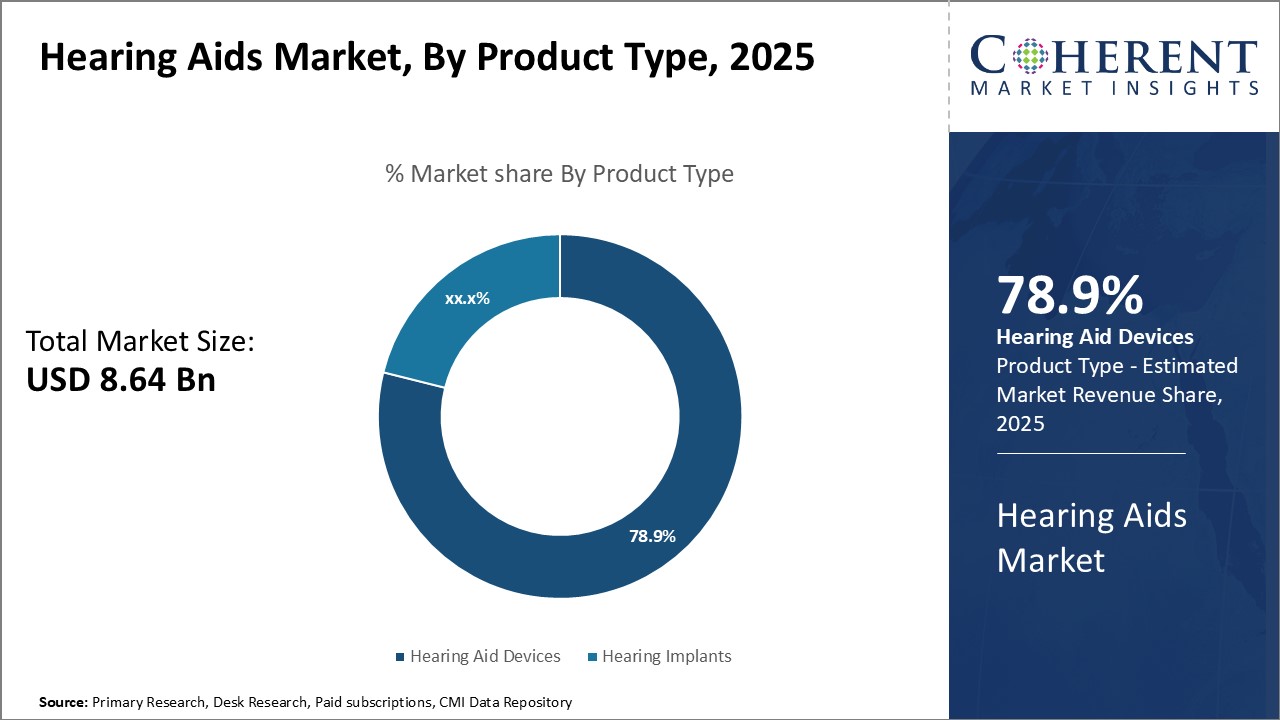
Discover high revenue pocket segments and roadmap to it: Request sample copy
Insights, By Product Type: Technology Advancements Fuel Growth of Hearing Aid Devices SegmentProduct Type segment is sub-segmented into hearing aid devices and hearing implants. Hearing aid devices segment is anticipated to hold 78.9% of the market share in 2025. Hearing aid devices have transformed significantly over the past few decades, becoming more comfortable, affordable and discreet. Advanced digital technology allows devices to filter ambient noise and focus on wanted speech sounds. Software-based programs fine-tune hearing aids for individual needs and listening environments. Rechargeable batteries have made devices more convenient while miniaturization makes them less visible. Leading manufacturers regularly release innovative new models with advanced features like Bluetooth connectivity, telecoil technology and smart phone integration. As a result, devices appeal to a wider range of ages and hearing losses. Rapid pace of innovation keeps consumers upgrading to latest versions for improved functionality.
Insights, By Type of Heating Loss: Genetic Factors Drive Demand for treatment of Sensorineural Hearing Loss
Type of heating loss segment is sub-segmented into conductive hearing loss, sensorineural hearing loss, and mixed hearing loss. Sensorineural hearing loss segment contributes the highest share of the hearing aids market and is projected to hold 47.3% of the market share in 2025. Approximately 50-60% of cases are attributed to hereditary damage or degeneration of inner ear sensory cells and auditory nerves over time. Family history is a strong risk factor as many types demonstrate Mendelian or complex inheritance patterns. Additionally, certain genetic mutations and syndromes are linked to childhood-onset cases. Expanding pool of elderly population also contributes to growing prevalence as risk increases with aging. Advancements in genetic testing technologies facilitate screening and diagnosis. Improved understanding of genetic influences on disease pathology guides innovation of targeted therapeutics to potentially stop or reverse the damage. These factors boosts demand for hearing aids and implants addressing sensorineural deficiencies.
Insights, By Patient Type: Growing ageing population suffering from hearing loss
The patient type segment is sub-segmented into adults and pediatrics. Adults segment contribute the highest share of the hearing aids market and is projected to hold 78.7% of the market share in 2025. Presbycusis or age-related hearing loss affects about 40-50% of 65–75-year-olds and up to 80% of those above 75 years. It is typically bilateral, progressive and permanent. Pathology involves degeneration of cochlear hair cells and neural connections over time. Lifestyle noise exposure from occupations like farming, construction also adds to adult non-congenital cases. Impaired communication poses challenges for independent living and workplace safety. Thus, many adults opt for hearing aids or implants due to quality-of-life considerations such as safety and social engagement. Affordability of devices for this cash pay group further fuels demand. In contrast, congenital or early onset cases may require treatment throughout entire lifespan for pediatric to adult care.
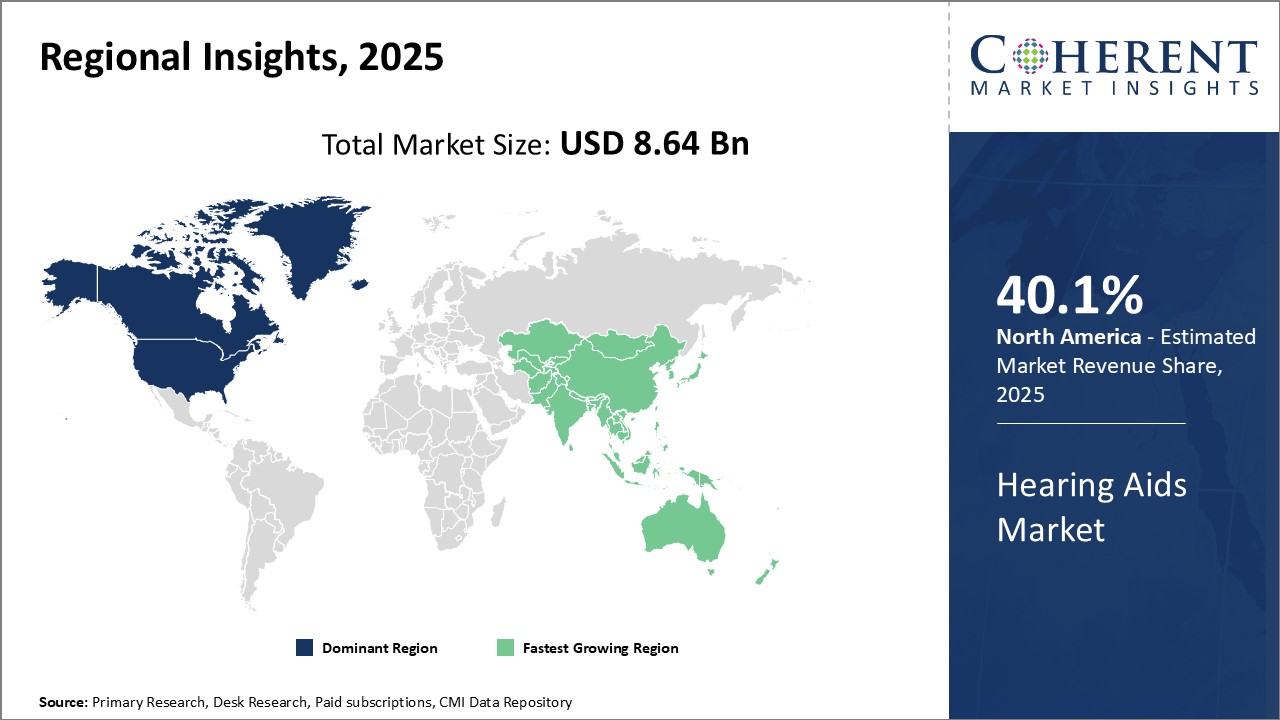
Need a Different Region or Segment? Customize now
The North America region currently dominates the global hearing aids market and is projected to hold 40.1% of the market share in 2025. With the U.S. accounting for the majority of sales, factors such as the high penetration of digital hearing aid devices, presence of leading global manufacturers, and growing geriatric population have contributed to its large market share. Moreover, favorable insurance coverage and reimbursement policies have facilitated market expansion.
The Asia Pacific region, on the other hand, is emerging as the fastest growing market for hearing aids. Rapid economic development and rising disposable incomes have increased spend on healthcare across nations like China, India and South Korea. This has driven focus onto quality-of-life aspects including hearing loss. Growing medical tourism in these countries is also encouraging device imports. Key players like Sonova and Demant are establishing local manufacturing units in Asia to address the untapped regional demand. This allows addressing specific price sensitivities and complies with developing "Make in India" policies. Their economies of scale and trusted brand names give an edge over domestic players. Leading distributors are also forming strategic tie-ups with regional insurers to gain market coverage.
Hearing Aids Market Report Coverage
| Report Coverage | Details | ||
|---|---|---|---|
| Base Year: | 2024 | Market Size in 2025: | USD 8.64 Bn |
| Historical Data for: | 2020 To 2024 | Forecast Period: | 2025 To 2032 |
| Forecast Period 2025 to 2032 CAGR: | 6.6% | 2032 Value Projection: | USD 13.52 Bn |
| Geographies covered: |
|
||
| Segments covered: |
|
||
| Companies covered: |
Sonova, Starkey Laboratories Inc., GN Hearing, Oticon, Demant A/S, Cochlear Ltd., Eargo Inc., WS Audiology A/S, RION Co. Ltd., MED-EL (Medical Electronics), Amplifon S.p.A, Audina Hearing Instruments Inc., Sonic Innovations Inc., Zounds Hearing., Audicus, Horentek Hearing Diagnostics, SeboTek Hearing Systems, LLC |
||
| Growth Drivers: |
|
||
| Restraints & Challenges: |
|
||
Uncover macros and micros vetted on 75+ parameters: Get instant access to report
*Definition: The hearing aids market consists of devices that amplify sound for the wearer. They are used by people suffering from hearing loss of different ranges from mild to severe. Hearing aids come in various styles including behind-the-ear, in-the-ear, and completely-in-the-canal devices. They utilize microphones to capture sound, an amplifier to increase the volume of sound, and a speaker to transmit the amplified sound.
Share
Share
About Author
Manisha Vibhute is a consultant with over 5 years of experience in market research and consulting. With a strong understanding of market dynamics, Manisha assists clients in developing effective market access strategies. She helps medical device companies navigate pricing, reimbursement, and regulatory pathways to ensure successful product launches.
Missing comfort of reading report in your local language? Find your preferred language :
Transform your Strategy with Exclusive Trending Reports :
Frequently Asked Questions
Joining thousands of companies around the world committed to making the Excellent Business Solutions.
View All Our Clients
US Reciprocal Tax Impact Analysis On Hearing Aids Market
Stay updated on tariff changes with expert insights and timely information